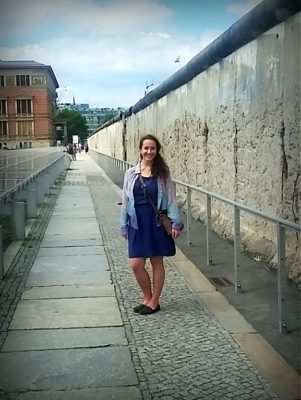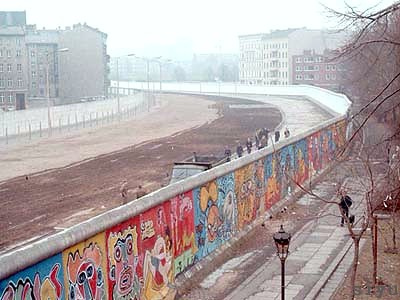As appearing in the Collegian
In 1961, the Berlin Wall was constructed as a physical barrier between political ideals. The wall separated the city into “East Berlin” and “West Berlin”, standing as a barricade between Communist and western ideologies. The wall fell in 1989, after international opposition and political unrest resulted in its deconstruction.
Yesterday, I saw the wall. It was not what I had imagined.
After growing up in the American school system, I was well-acquainted with the rhetoric surrounding the horrors of Communism. Since elementary school, I have been showered with anti-Communist, pro-capitalist messages that boasted about the success of American democracy while demonizing the failures of overt socialist regimes. Even at home, my mother would tell me stories about how she practiced air-raid drills at her small public elementary school in upstate New York during the Cold War. When I visited my grandfather, he would tell me stories about fighting in World War II and the atrocities committed by Communist and Fascist regimes.
So, like many American school children, I had heard many stories. Also like many American school children, I had never seen the wall.
When my friends and I made a stop on our bus tour across Berlin, I was able to see the wall for the first time. As I stated earlier, it was not what I had imagined. For some reason, I thought that the wall would be larger than it actually was.

I suppose I imagined that it would stand like a lofty monument upon the horizon. I thought that it would be an antagonistic, grey behemoth that captured the imagination with countless terrors. I thought that the remaining stones would be rough and gaudy, standing like arrogant martyrs in resistance to the pull of history.
However, the wall was just a wall. It was smaller than I imagined. The short stretch that was left was reinforced with rusting iron poles that had curved against the pressures of gravity and time. The cement wall was thin and gaunt, like a weak old man lacking the power to rise from an uncomfortable armchair. Without its historical context, what was left of the wall would be thoroughly unimpressive. However, the plaques that stood at the base of the wall told the stories of those affected by this barricade. It told Cold War stories, soldier stories, family stories, political stories, the stories that break the heart.
At one time, the wall was covered in graffiti in protest of everything that resulted from its assembly: isolation, fear, and anger. In gift shops across Berlin, one can purchase a small piece of the painted wall for a few Euros. One can purchase a moment in time for such a small sum. Perhaps this action is the true triumph of capitalism over Communism. However, I digress.
As I observed the wall, it occurred to me that this form of separation is not an unusual form of human expression. Walls are built on a regular basis as a form of protection from a perceived threat. We build walls to separate bathroom stalls from those we wish to exclude. We put up emotional walls to block ourselves from intellectual discomfort. We hear politicians deliver passionate speeches about walls to maintain national security. It seems that the human condition has historically been marked by the construction of walls. It is in our nature to be exclusionary.
Yet, as I mentioned, the pieces of concrete that were for sale in the German gift shops were portions of the painted wall. At one point, that paint was a symbol of resistance. Before the wall fell, graffiti covered the bleak cement with color, life and expression. The artists that left their mark on the surface articulated their grit, passion and opposition to those that placed restrictions upon human freedom. It is the art, and the spirit of resistance within the art, that has survived. Art is not exclusionary. It is not used to create barriers that separate humans from one another, but instead seeks to open them. Art invites all to come, observe, contemplate and reflect.
As I looked upon the Berlin Wall, another wall that has yet to be constructed came to mind. The Berlin Wall stood as a form of outright separation between a group that was perceived as a threat to the other. The one that may be constructed in the near future would be built upon the same principle. When I looked upon the crumbling concrete that remained, it would have been easy to consider this monument a thing of the past, a remnant of a foreign order. Yet, when I hear stories about the construction of a similar wall on my home soil, reality comes like a harsh slap in the face.

Humans have been building walls for millennia. Walls are visible, sturdy and forceful expressions of ideologies. Walls can make us feel safe, sheltered and comfortable. Yet there are times when one is forced to reconcile with the notion that the threats the walls are meant to protect us from are not necessarily dangerous. The walls that we may form around our minds, hearts, homes and borders may seem necessary in the moment, yet can also have devastating consequences. And thus the walls become the threat.
One can never be exposed to a new idea when a wall is constructed around the mind. One may never feel the warmth of human love when the heart is surrounded by an encampment. The pleasure of human interaction will not be experienced when one isolates their home and themselves from the rest of the world. A great exchange of ideas, experiences and resources will never occur when barriers are placed between borders.
Therefore, the ruins of the Berlin Wall taught me that interpersonal exchanges are more important than isolation, and that even in the face of the most advanced obstacles, the human spirit will triumph.
The fall of the wall was a moment of victory. Let us now be wise and refrain from repeating the mistakes of the past.
